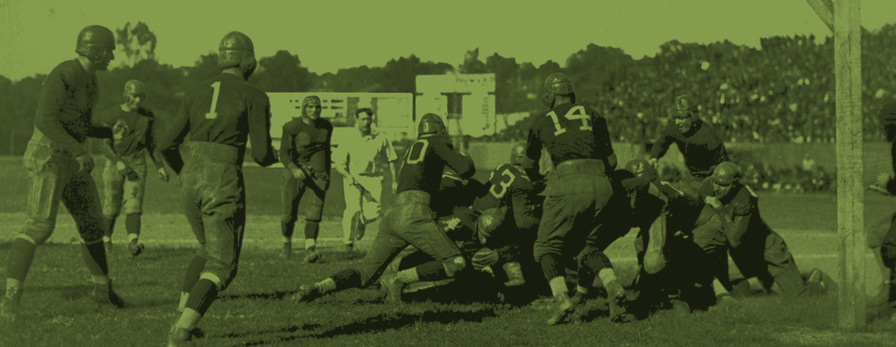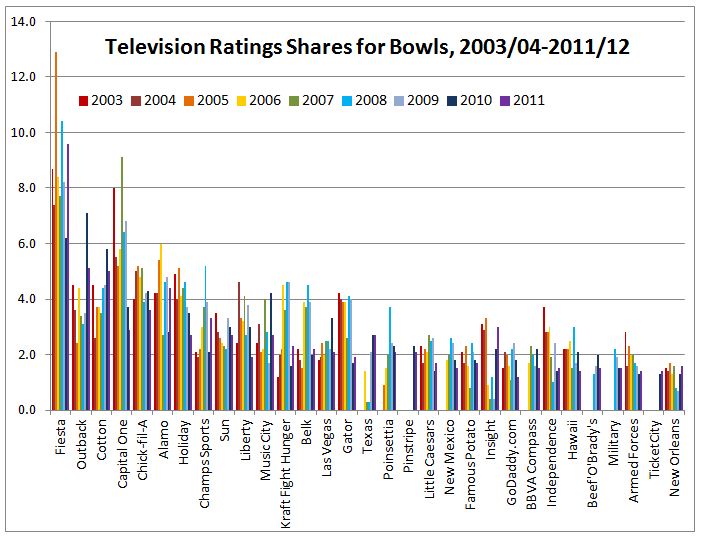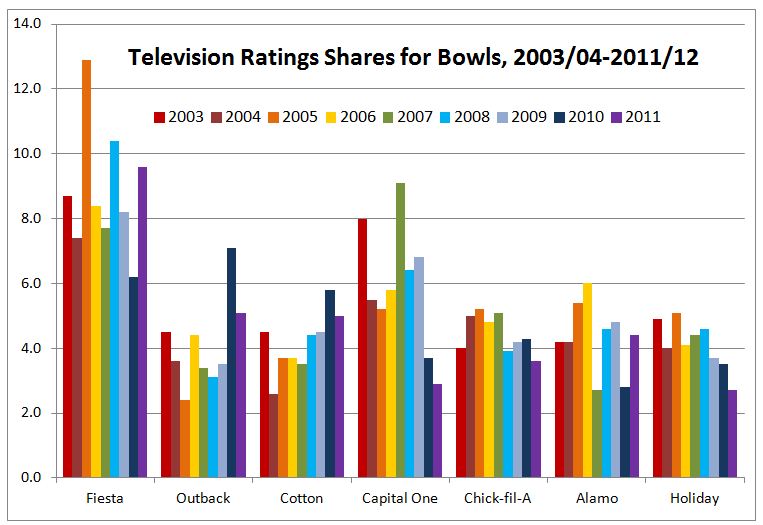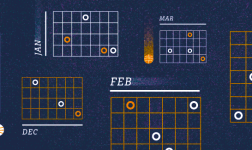A few weeks ago, the college football world got a more definitive view of what the future holds when it was announced that the new postseason system will include six bowls. Three of those bowls are “Contract” bowls, which have automatic ties to conferences: the Rose Bowl (Big Ten and Pac 12), the Sugar Bowl (SEC and Big 12), and the Orange Bowl (ACC and SEC/Big Ten/Notre Dame).
The other three are “Host” bowls, which will be chosen in the very near future. Currently the front-runners are the Fiesta Bowl, the Cotton Bowl, and the Chick-fil-A Bowl—but perhaps we can look at why and whether that might change.
With Maryland and Rutgers recent announcements that they were leaving the ACC and Big East Conferences, respectively, to join with the Big Ten Conference, it’s apparent that television revenue plays a role when it comes to the college bowl landscape. We looked at the recent performances of the bowls with regard to television viewers, and here’s what we found:
The top bowls likely maintain the best shot at landing a coveted “Host” spot, so let’s look at them more closely.
The Fiesta Bowl has probably earned a “Host” spot with their strong showing. Not only has it been a part of the BCS since its inception, but it also brings in the highest TV ratings of this group (garnering higher than an 8.0 in five of the last nine seasons, while only one of the other bowls had a single season above that mark.) With this insight we would expect two remaining spots up for grabs.
The Outback bowl performed well recently, but did not reach 5.0 from 2003-2009. It also experiences ratings fluctuations, with an average swing of over 33% per year. The Cotton Bowl’s numbers are similar, averaging about what the Outback did, but with less fluctuation (with a 22% average swing) and has trended upward for the last eight seasons. The Capital One Bowl has had some high marks, and was over 5.0 from 2003-2009. It has not performed at its typical level over the past two seasons, however. The Chick-fil-A Bowl is a steady performer, with just a 13% average swing any given year, but could stand to improve on their average of 4.5. The Alamo Bowl is a bit of a surprise, not known typically as carrying the largest audience.
The numbers tell the story, however, and the Alamo Bowl has been seen by more viewers since 2003 than the Outback or Cotton. Finally the Holiday Bowl is also steady, with just an 18% average swing any given season. It will likely look to reverse a downward trend over the last four years. The television ratings would seem to give a slight edge to the Outback, Cotton, and Capital One.
But television ratings aren’t the only component of this equation. Another factor that might come into play is location. In addition to providing a great deal of benefit to each of their communities year round, bowls in the “Contract” games – the cities of Los Angeles (Pasadena), New Orleans, Phoenix, and Miami are represented – represent four major destinations for winter tourists or football fans. The Cotton Bowl would bring the Dallas-Fort Worth market into play and be staged at Jerry Jones’s new billion-dollar facility in Arlington. The Outback and Capital One are in Tampa and Orlando, Florida, respectively. There are enough tourists that flock to the Sunshine State for another bowl, but the region would benefit from bowls housed at newer stadiums allowing increased attendance.
The Chick-Fil-A Bowl may have the biggest geographical advantage, being in Atlanta, Georgia. The Alamo Bowl represents another Texas town, San Antonio, while the Holiday Bowl is down the road from L.A. in San Diego. The Cotton and Chick-fil-A will surely benefit from their locations.
Another good indicator of which potentials may end up being “host” bowls can be found in the conference tie-ins that are currently in place. The order that the bowls choose their participants is determined by their contracts – so which are some of the most favorable?
The Capital One Bowl would seem to be near the top, since it has the second picks from the SEC and the Big 10, arguably the two strongest conferences in terms of fan support. The Cotton Bowl has the second pick of the Big 12 and the third or fourth pick from the SEC, which also puts it near the top. The Outback Bowl has the third or fourth pick from the SEC as well, but paired with the fourth pick from the Big 10. Next is the Chick-fil-A Bowl, which has the second pick from the ACC and the fifth pick from the SEC. The Alamo Bowl gets the second pick from the Pac 12 with the third pick from the Big 12. Finally, the Holiday Bowl gets the third pick from the Pac 12, with the fifth pick from the Big 12. The Capital One and Cotton seem to be in favorable positions.
Based on these results, the Cotton Bowl is a likely choice, ranking highly in all three areas. The Alamo and Holiday Bowls seem less probable, since they ranked lower in the three categories. That leaves the Outback, Capital One, and Chick-fil-A Bowls. In this situation, the locale of Atlanta is probably a deciding factor, since the other two are located in Florida, where the BCS bowls already have a base in the Orange Bowl.
But one more factor might come into play also – the Chick-fil-A Bowl brand is growing, adding a kickoff game in August of 2008, and a second kickoff game this past 2012 season. The appeal of these games is increasing, and the way in which the Chick-fil-A Bowl’s stature has been raised might be enough to earn it the final “Host” bowl spot.
Key Insights
We looked likely top bowls with the best shot at landing a coveted “Host” spot. Currently the front-runners are the Fiesta Bowl, the Cotton Bowl, and the Chick-fil-A Bowl. However, a closer examination finds that the Fiesta Bowl has probably earned a “Host” spot, a part of the BCS since its inception, but it also brings in the highest TV ratings of this. The Capital One and Cotton also seem to be in favorable positions. Additionally, the Chick-fil-A Bowl’s stature has been raised and might be enough to earn it the final “Host” bowl spot.






